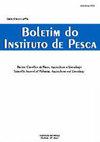IN VITRO ANTIMICROBIAL ACTIVITY OF CARVACROL AGAINST SHRIMP PATHOGENS AND ITS USE AS FEED ADDITIVE FOR THE PACIFIC WHITE SHRIMP
IF 0.6
4区 农林科学
Q4 FISHERIES
引用次数: 2
Abstract
This study aimed to evaluate the in vitro effect of carvacrol on different microorganisms of importance in shrimp farming, as well as its in vivo effect on zootechnical, immunological and microbiological performance, as well as resistance, of Litopenaeus vannamei challenged with Vibrio parahaemolyticus. In particular, the antimicrobial activity of carvacrol was evaluated in vitro by analysis of the minimum inhibitory concentration (MIC) and by agar diffusion disc with Gram-negative and Gram-positive bacteria. The in vivo experiment was conducted using different concentrations of carvacrol (1, 3, 4 and 6 mg mL-1) added to shrimp feed, together with a control diet without carvacrol. After four weeks, zootechnical, immunological and microbiological parameters, as well as resistance, of animals challenged with V. parahaemolyticus were evaluated. The MIC of Vibrio alginolyticus and Vibrio harveyi was 0.078 mg mL-1, while for the other bacteria, it was 0.156 mg mL-1 of carvacrol. The greatest halos of inhibition were observed in V. parahaemolyticus and Vibrio harveyi with significant differences demonstrated for the other microorganisms, except Escherichia coli. The in vivo results showed no significant differences among treatments. In conclusion, the antimicrobial activity of carvacrol was confirmed with Gram-negative and Gram-positive bacteria, and it is suggested that its antimicrobial potential is more effective against Vibrio spp. However, the concentrations of carvacrol used in vivo did not affect the parameters evaluated.香芹酚对对虾病原菌的体外抑菌活性及其在太平洋白虾饲料添加剂中的应用
本研究旨在评价芫花酚对对虾养殖中不同重要微生物的体外影响,以及其对副溶血性弧菌攻毒的凡纳滨对虾(Litopenaeus vannamei)动物技术、免疫学和微生物学性能及耐药性的体内影响。特别是,通过分析最低抑菌浓度(MIC)和琼脂扩散盘对革兰氏阴性和革兰氏阳性细菌的抑菌活性进行了体外评价。在对虾饲料中添加不同浓度的香芹酚(1、3、4和6 mg mL-1),并在不添加香芹酚的对照饲料中进行体内试验。四周后,对感染副溶血性弧菌的动物进行动物技术、免疫学和微生物学参数以及耐药性评估。溶藻弧菌和哈维弧菌的MIC为0.078 mg mL-1,其他菌的MIC为0.156 mg mL-1。副溶血性弧菌和哈维弧菌的抑制效果最大,除大肠杆菌外,其他微生物的抑制效果差异显著。体内实验结果显示不同处理间无显著差异。综上所述,香芹酚对革兰氏阴性菌和革兰氏阳性菌的抑菌活性得到了证实,表明其对弧菌的抑菌潜力更强,但体内使用的香芹酚浓度不影响其抑菌活性。
本文章由计算机程序翻译,如有差异,请以英文原文为准。
求助全文
约1分钟内获得全文
求助全文
来源期刊

Boletim do Instituto de Pesca
FISHERIES-ZOOLOGY
CiteScore
0.80
自引率
0.00%
发文量
24
审稿时长
>12 weeks
期刊介绍:
To publish original articles of research and short communications in the following áreas: Fisheries, Aquaculture, Zootechnology, Limnology, Oceanography, Biology and Pathology of aquatic organisms. The publication depends on the approval of the Editorial Board, based on the peer review.
 求助内容:
求助内容: 应助结果提醒方式:
应助结果提醒方式:


